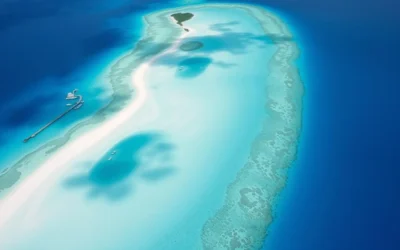✓ Accommodations✓ Flights✓ Rental Cars
Imagine visiting a paradise with crystal-clear lagoons and rich Polynesian culture, where fewer than a hundred visitors make the journey each year. Tuvalu, a tiny island nation in the Pacific, offers an unspoiled getaway for the adventurous traveler. With its fragile ecosystem and limited tourism infrastructure, planning your trip at the right time is crucial.
Tuvalu’s unique geographical location midway between Hawaii and Australia significantly influences its climate patterns throughout the year. Understanding these variations is key to enjoying your trip. As you prepare for your weather-savvy trip, consider the delicate balance between appreciating Tuvalu’s natural beauty and respecting its vulnerable environment.
By choosing the best time to visit, you can ensure a memorable experience in this enchanting island nation. Get ready to explore one of the world’s least visited destinations, where paradise beaches and clear lagoons await.
Understanding Tuvalu’s Tropical Climate
Located halfway between Hawaii and Australia, Tuvalu’s climate is influenced by its geographic position. Tuvalu enjoys a warm, but rainy, climate year-round, with the rainy season lasting from November to February, and cyclone season from November to April.
Geographic Location and Its Impact on Weather
Tuvalu’s geographic location in the Pacific Ocean significantly impacts its weather patterns. The islands are exposed to tropical weather conditions, including high temperatures and significant rainfall during certain periods of the year. The warm ocean waters surrounding the islands contribute to the overall warm climate, making Tuvalu a tropical destination ideal for travel throughout the year.
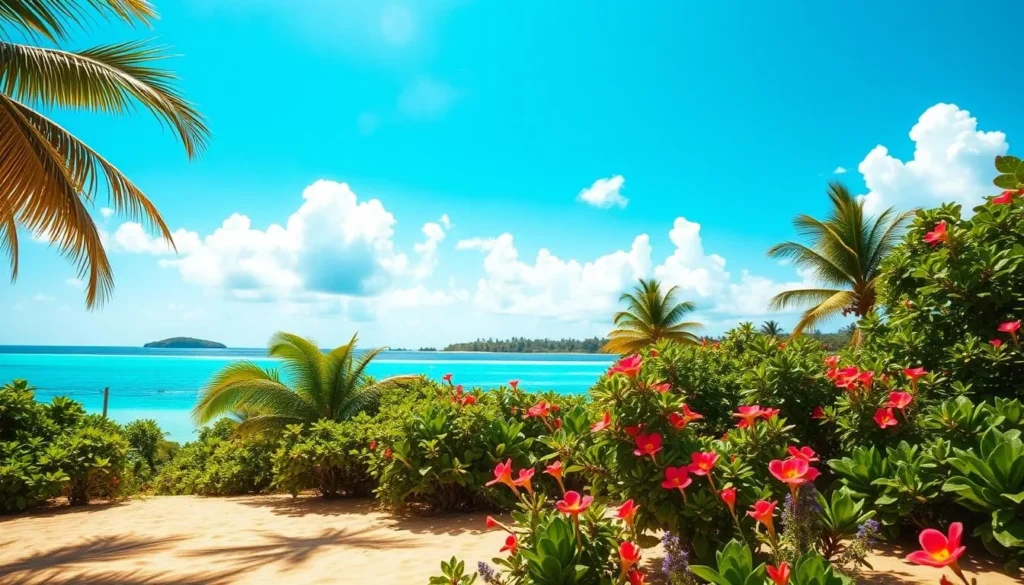
Year-Round Temperature Patterns
Tuvalu’s temperature remains remarkably consistent throughout the year, typically ranging between 80-90°F (26-32°C) during the day. You can expect minimal seasonal temperature variations, making Tuvalu a warm-weather destination regardless of when you travel. Some key aspects to consider:
- Consistent daytime temperatures around the islands
- Pleasantly warm ocean temperatures ideal for swimming and water activities
- Minimal drop in nighttime temperatures, creating comfortable evening conditions
- Steady temperature patterns that influence what to pack for your visit
Understanding these temperature patterns will help you prepare for your trip to this tropical paradise.
Tuvalu: Best Months for a Weather-Savvy Trip
When planning your trip to Tuvalu, understanding the best time to visit can make all the difference. Tuvalu’s climate is characterized by distinct wet and dry seasons, which significantly impact the quality of your visit.
May to October: The Prime Dry Season
The dry season, spanning from May to October, is considered the prime time to visit Tuvalu. During these months, you can expect minimal rainfall and plenty of sunshine, making it ideal for outdoor activities such as snorkeling, diving, and exploring the islands. As a traveler, you’ll appreciate the favorable weather conditions that allow for a wide range of activities without the hindrance of rain.
| Month | Average Rainfall (mm) | Average Sunshine Hours |
|---|---|---|
| May | 120 | 8 |
| June | 100 | 9 |
| July | 80 | 9 |
| August | 70 | 9 |
| September | 90 | 8 |
| October | 110 | 8 |
Shoulder Seasons: April and November
For travelers who are flexible with their plans, the shoulder seasons offer a good compromise. April represents the transition from the wet to the dry season, with gradually decreasing rainfall and improving conditions. November, on the other hand, marks the beginning of the wet season, with increasing chance of rain but still plenty of sunny periods between showers. When planning your trip during these shoulder months, be prepared for less predictable weather patterns, which can require more flexibility in your itinerary.
Visiting during the shoulder seasons can offer several advantages, including fewer travelers and potentially lower accommodation rates, making it a more budget-friendly option. Additionally, the changing weather patterns during these months create unique photographic opportunities with dramatic skies and lighting conditions.
Rainfall Patterns Throughout the Year
Understanding Tuvalu’s rainfall patterns is crucial for planning your trip. The island’s tropical climate is marked by distinct wet and dry seasons, which significantly impact the activities you can enjoy during your visit.
Wet Season: November to April
During the wet season, Tuvalu experiences heavy rainfall, with some months receiving over 15 inches of rain. This period is characterized by increased humidity and more frequent tropical showers. While the lush vegetation that results from the rain can be beautiful, the wet conditions may limit some outdoor activities on the island.
Drier Months: May to October
The dry season, from May to October, offers more favorable conditions for outdoor activities. During these months, Tuvalu typically receives less than 8 inches of rainfall per month. The reduced rain creates more comfortable conditions for exploring the island and engaging in cultural experiences. You can enjoy activities like snorkeling and diving in clearer waters.
| Month | Average Rainfall (inches) | Weather Conditions |
|---|---|---|
| May | 6 | Dry, sunny |
| June | 5 | Dry, sunny |
| July | 4 | Dry, sunny |
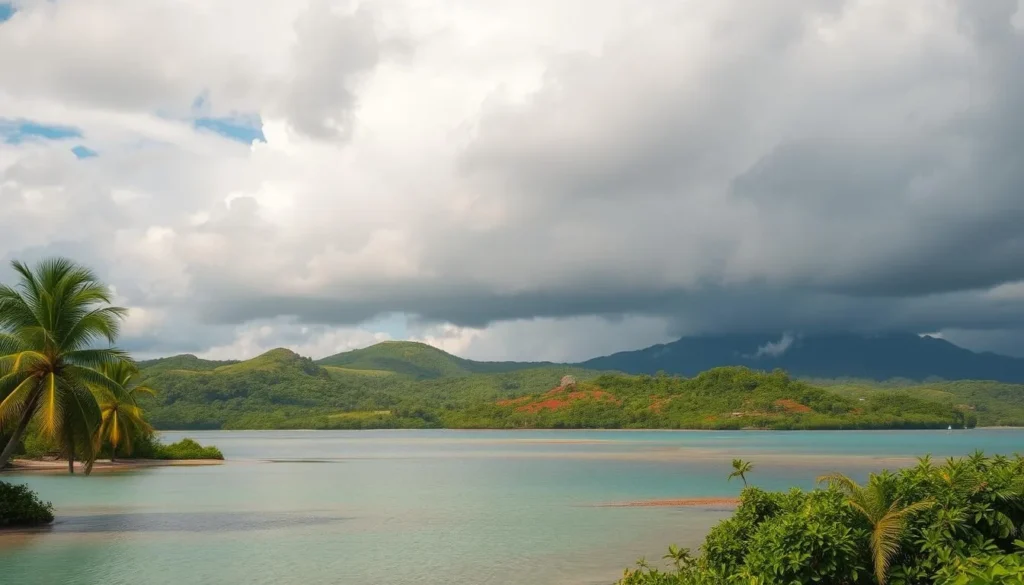
Sunshine and Cloud Cover by Month
Sunshine and cloud cover are critical factors to consider when deciding the best time to visit Tuvalu. The island’s tropical climate means that these factors vary significantly throughout the year, impacting your travel plans and the activities you can enjoy.
Clearest Skies: May to October
From May to October, Tuvalu experiences its clearest skies, making it an ideal period for outdoor activities and sightseeing. During these months, the weather is generally dry and sunny, with minimal cloud cover. This period is perfect for enjoying the island’s beautiful beaches and engaging in activities like snorkeling and diving.
- The dry season brings clear skies, ideal for stargazing and photography.
- You can enjoy uninterrupted sunshine, with an average of 8-9 hours of direct sunlight daily.
Overcast Periods: November to April
In contrast, the period from November to April is characterized by more frequent cloud cover, coinciding with Tuvalu’s wet season. November is particularly cloudy, with overcast or mostly cloudy skies 85% of the time. While this might deter some travelers, the cloud cover can actually create more comfortable conditions for certain activities by reducing direct sun exposure.
- During these months, Tuvalu typically experiences 4-6 hours of direct sunshine daily.
- The changing cloud patterns create dramatic skies, especially during sunrise and sunset, making for great photography opportunities.
- December and January are the cloudiest months, coinciding with the peak of the wet season.
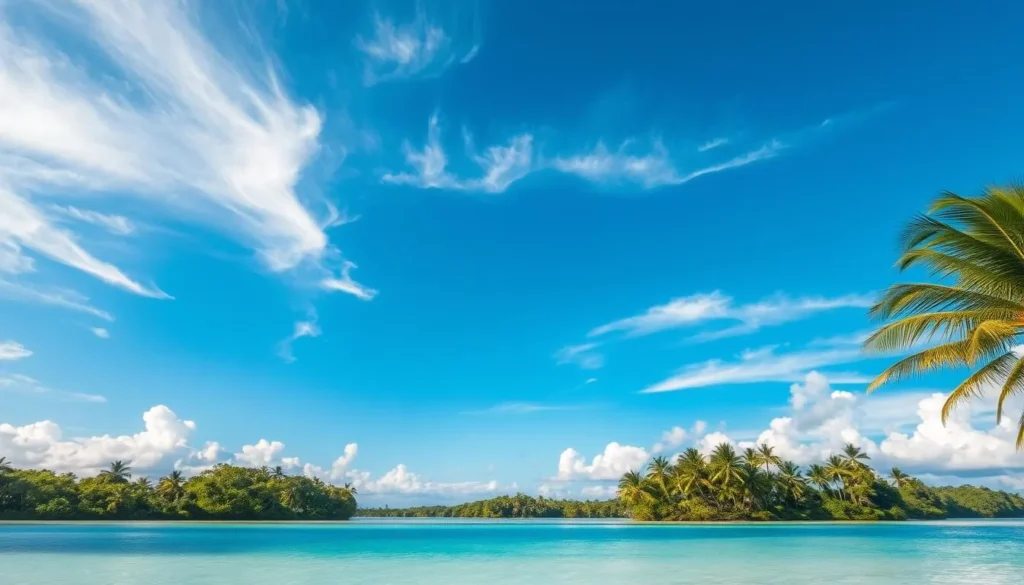
Wind Conditions and Their Seasonal Variations
As you plan your trip to Tuvalu, it’s essential to consider the seasonal wind variations. Understanding these patterns can help you make the most of your visit and prepare for any potential weather-related challenges.
Trade Winds: May to October
From May to October, Tuvalu experiences consistent trade winds that bring a pleasant breeze to the islands. This period is characterized by relatively stable wind directions, making it an ideal time for outdoor activities such as sailing and fishing. The trade winds also contribute to the dry season, making the weather even more favorable for tourists.
Calmer Periods and Cyclone Season
The calmer period, lasting 5.2 months from June 21 to November 27, offers a more tranquil experience. September is the calmest month, with an average hourly wind speed of 9.4 miles per hour. However, it’s also important to be aware of Tuvalu’s cyclone season, which officially runs from November to April. While direct hits are rare, occurring once every 7-10 years on average, it’s crucial to stay informed about weather conditions during this time.
| Month | Average Wind Speed (mph) | Weather Conditions |
|---|---|---|
| June | 12.1 | Trade winds, dry |
| September | 9.4 | Calm, dry |
| November | 11.5 | Transition to cyclone season |
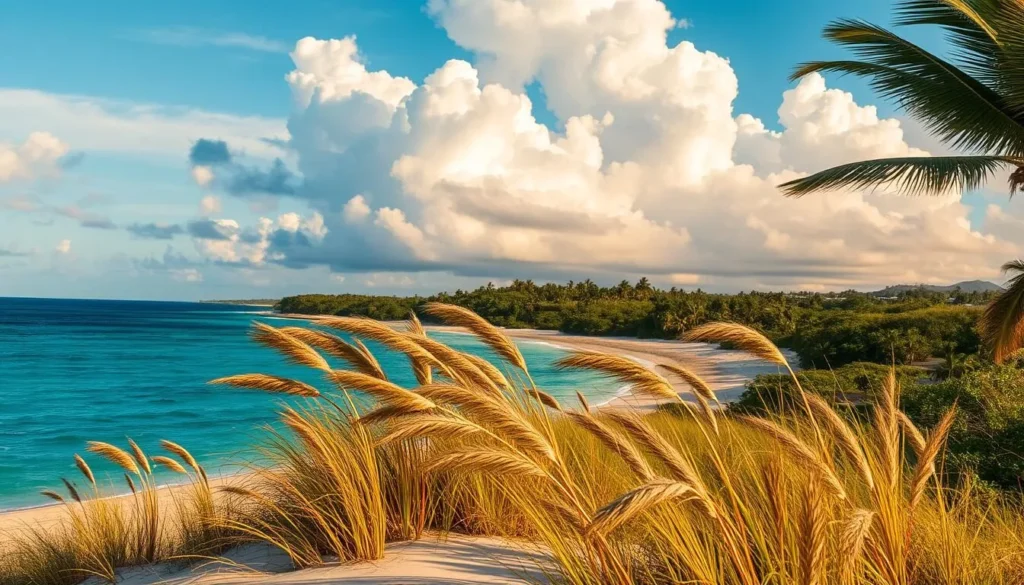
Tuvalu’s location on the edge of the Pacific cyclone belt means that while cyclones can occur, they are relatively rare. Changing wind directions during the cyclone season can bring warmer air masses from the equator, contributing to higher humidity levels. It’s essential to recognize the warning signs and preparation measures that Tuvaluans take during cyclone season, and what travelers should know about emergency procedures.
Water Temperature and Ocean Activities
Tuvalu’s crystal-clear waters offer a paradise for ocean enthusiasts, with a diverse range of activities to enjoy throughout the year.
The warm sea temperatures make it an ideal destination for swimming, snorkeling, and diving. The coral reefs surrounding Tuvalu are home to a vibrant array of marine life, making it a perfect time to visit for those who love the ocean.
Best Months for Swimming and Snorkeling
The best time for swimming and snorkeling in Tuvalu is during the dry season, from May to October, when the waters are calm and clear. You can enjoy exploring the coral reefs and spotting marine life in the pristine waters.
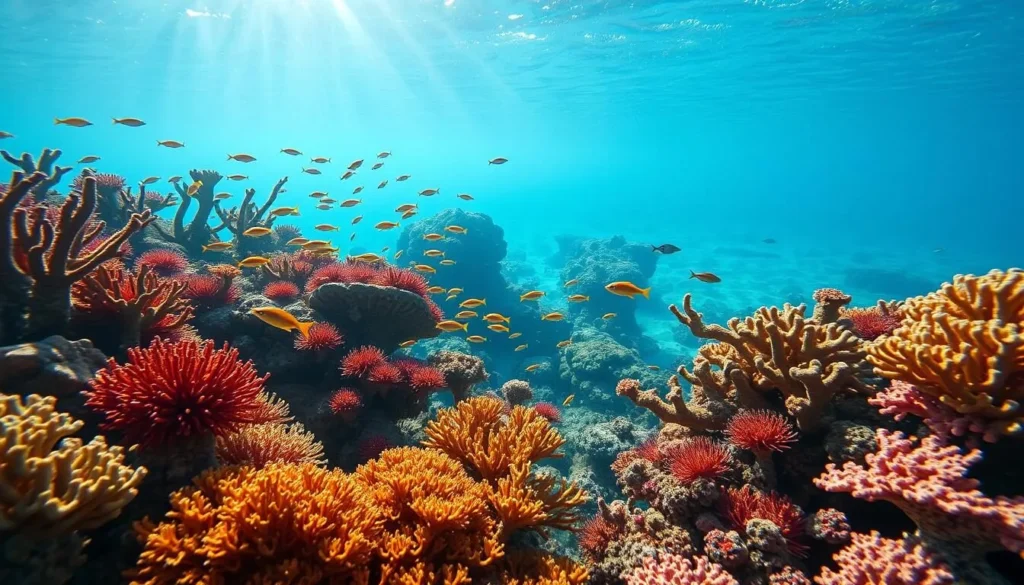
Diving Conditions Throughout the Year
Tuvalu offers excellent diving conditions throughout the year, with visibility often exceeding 100 feet during the dry season. The calm seas from May to October create ideal conditions for diving, allowing you to explore the underwater world with ease. Whether you’re visiting the beach or diving into the ocean, Tuvalu has something to offer for every ocean enthusiast.
Humidity Levels and Comfort Factors
Understanding humidity levels is crucial for a comfortable trip to Tuvalu. The tropical climate means high humidity throughout the year, but there are periods that are more comfortable than others for outdoor activities.
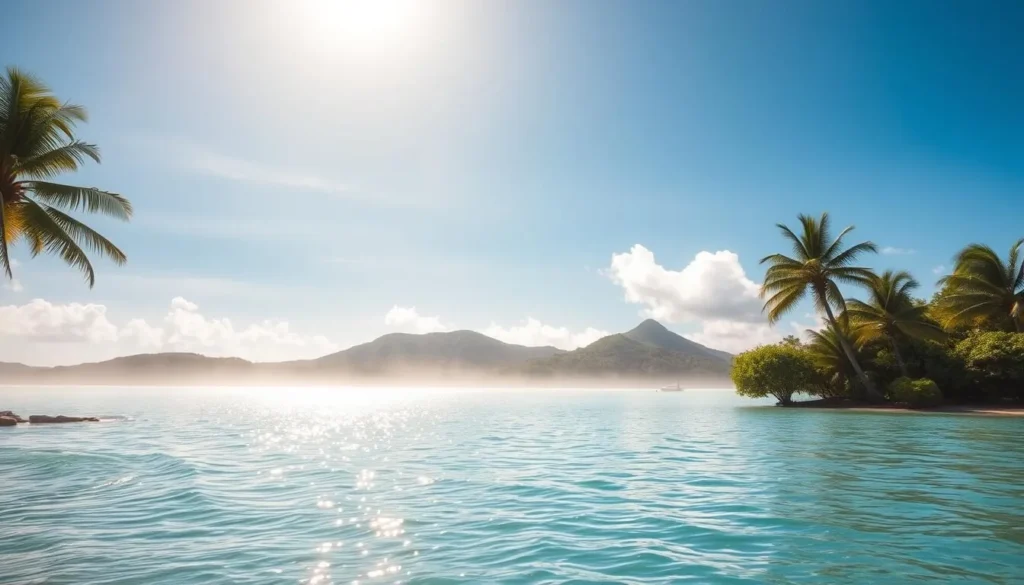
Managing High Humidity
Tuvalu’s humidity can be challenging, especially during the wet season from November to April. To manage high humidity, plan your activities around the cooler parts of the day, such as early morning or late afternoon. This strategy helps in making your travel experience more enjoyable.
Most Comfortable Periods for Outdoor Activities
The period from May to October is considered the most comfortable for outdoor activities in Tuvalu, with lower humidity and refreshing trade winds. During this time, the combination of moderate temperatures and consistent breezes creates ideal conditions for exploring the islands and engaging in cultural experiences. When planning your trip, consider this period for the best experience.
Planning Around Daylight Hours
With around 12 hours of daylight every day, travelers to Tuvalu can enjoy a wide range of activities without the constraint of limited daylight. This consistency allows for effective planning of your trip.
Sunrise and Sunset Patterns
The islands experience early sunrises, typically around 6:00 AM, and sunsets around 6:00 PM. Many visitors adapt to the local rhythm by rising early and concluding major activities by sunset. This natural rhythm enhances the overall experience.
Maximizing Daylight for Activities
To make the most of Tuvalu’s daylight, plan your daily itinerary to take advantage of the cooler morning hours for active pursuits like hiking or cycling. Different activities benefit from specific times of day, such as early morning for bird watching or late afternoon for photography. Aligning your activities with natural daylight not only maximizes your time but also helps you experience Tuvalu as locals do.
| Activity | Best Time | Reason |
|---|---|---|
| Bird Watching | Early Morning | Birds are most active |
| Swimming | Midday | Waters are warmest |
| Photography | Late Afternoon | Best lighting conditions |
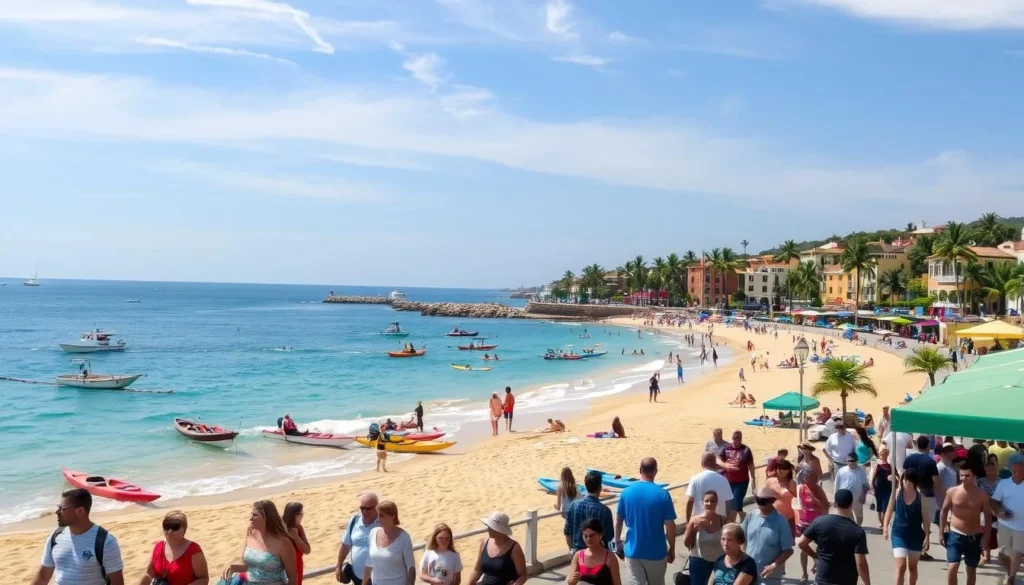
Best Months for Specific Activities
Tuvalu’s climate influences the best times for different activities, from beach relaxation to cultural exploration. Understanding these optimal periods can help you plan a more enjoyable trip.
Optimal Times for Beach Activities
The dry season, from May to October, is ideal for beach activities due to the calm seas and plenty of sunshine. During this period, the weather is more stable, making it perfect for swimming, snorkeling, and other water sports. You can enjoy the beautiful beaches of Tuvalu without the interruptions of rain or strong winds.
Ideal Periods for Cultural Exploration
For cultural exploration, the dry season also offers more reliable conditions for visiting outdoor cultural sites. You can participate in local festivals like Tuvalu Independence Day on October 1, and engage with the community through various cultural activities. The dry season allows for a more authentic experience, as you can interact with locals and witness traditional practices without the hindrance of wet weather.
Weather Considerations for Island Hopping
Weather plays a significant role in determining the success of your island-hopping adventure in Tuvalu. The country’s geography, with its numerous islands, makes weather a crucial factor in planning.
Inter-Island Travel and Weather Impacts
Traveling between Tuvalu’s islands can be affected by weather conditions. The outer islands, in particular, have limited transportation options, making it essential to plan around the weather.
- Understand that inter-island travel may be impacted by weather-related disruptions.
- Recognize that the January to April period is considered optimal for visiting the outer islands due to relatively more stable weather conditions.
Planning Multi-Island Itineraries
When planning your trip, building in buffer days is crucial to accommodate any weather-related delays. This is particularly important when traveling to the outer islands.
- Build flexibility into your trip itinerary to account for potential weather disruptions.
- Consider combining islands with similar weather patterns to maximize your chances of a successful island-hopping experience in paradise settings.
Conclusion: Making the Most of Your Tuvalu Visit
With its remote charm and authentic cultural experiences, Tuvalu is a destination that requires weather-savvy travel planning. Understanding the weather patterns can significantly enhance your visit to this Pacific paradise.
The dry season, from May to October, is ideal for most travelers due to its favorable conditions. However, Tuvalu’s unique experiences make it a worthwhile destination year-round for adventurous travelers.
To make the most of your visit, consider practical tips such as packing accordingly, choosing suitable accommodation, and planning activities. Respect local customs and environmental concerns to support Tuvalu’s sustainability efforts.
Tuvalu offers a chance to experience pristine lagoons, isolated communities, and a paradise-like atmosphere. With flexibility and a positive attitude, you can have a memorable trip. Understanding Tuvalu’s weather patterns enhances your trip, but the true value lies in experiencing this unique corner of the Pacific before it potentially changes forever.
The above is subject to change.
Check back often to TRAVEL.COM for the latest travel tips and deals.

